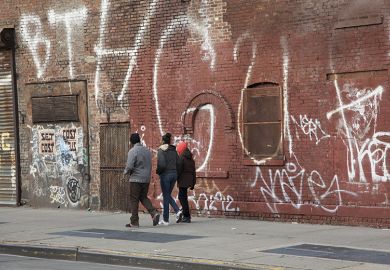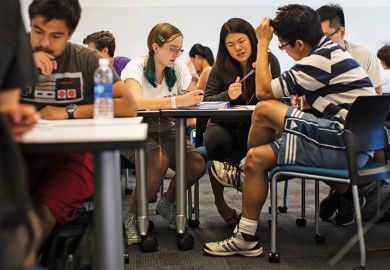Students will almost always choose to work with classmates of the same sex and ethnicity when they are asked to pair up, a new analysis suggests.
In a study at the University of Washington, in Seattle, researchers found that “in almost all cases, students self-sorted by ethnicity and gender”, while more academically able students also gravitated towards each other.
Tracking how students on an introductory biology course formed groups to discuss questions raised in lectures held in a large auditorium, academics observed an overwhelming trend towards “homophily”, in which those with similar characteristics grouped together, according to a paper, “Likes attract: Students self-sort by gender, demography and academic characteristics”, published recently in the journal Active Learning in Higher Education.
Students began to work with classmates from the opposite sex and from different racial groups only when they were seated close to teaching assistants dotted around a 700-seat lecture theatre to assist break-out discussions, the paper also states. However, this effect was short-lived, and students reverted to more homogeneous groups over the duration of the course, it adds.
In the class of about 700 students – where 45 per cent were white, 39 per cent Asian American, 5 per cent Hispanic and 3 per cent African American – learners often spoke to different classmates mid-lecture, but they tended to drift towards those of a similar academic ability as their course progressed, the paper adds.
“The relationship between past high achievers disappeared after day 2,” it states, saying “students who actually did well in the course, in terms of final grade, began associating”. Those with a history of struggling academically also increasingly worked together, it adds.
The paper, by University of Washington academics Scott Freeman, Roddy Theobald, Alison J. Crowe and Mary Pat Wenderoth, was initiated because, while group work is increasingly common in higher education, “virtually no data exist on which students are collaborating”, it explains.
With previous studies showing that group work is “particularly beneficial for students who arrive at university underprepared relative to their peers, including students who are first in their family to attend university, members of underrepresented minorities and from low socioeconomic backgrounds”, more work is required on how groups should be organised, the study says.
While it is “possible that homophily promotes success by maximising the efficiency of peer interaction” thanks to friends working together effectively, there is also evidence that it “may be dysfunctional because diverse experiences and points of view lead to improved outcomes”, the study reports, suggesting that “heterogeneous groups may maximise student learning”.
However, while lecturers should seek to “avoid accepting heterogenous groups as a default condition”, they should also be careful about “structuring…groups in a naïve way that could either add to the barriers faced by underrepresented students or encourage struggling students to be passive”, the paper concludes.
“There may be a role for carefully designed interventions to lower social barriers to interaction and support…social comfort in heterogeneous groups,” it adds.
Register to continue
Why register?
- Registration is free and only takes a moment
- Once registered, you can read 3 articles a month
- Sign up for our newsletter
Subscribe
Or subscribe for unlimited access to:
- Unlimited access to news, views, insights & reviews
- Digital editions
- Digital access to THE’s university and college rankings analysis
Already registered or a current subscriber?








